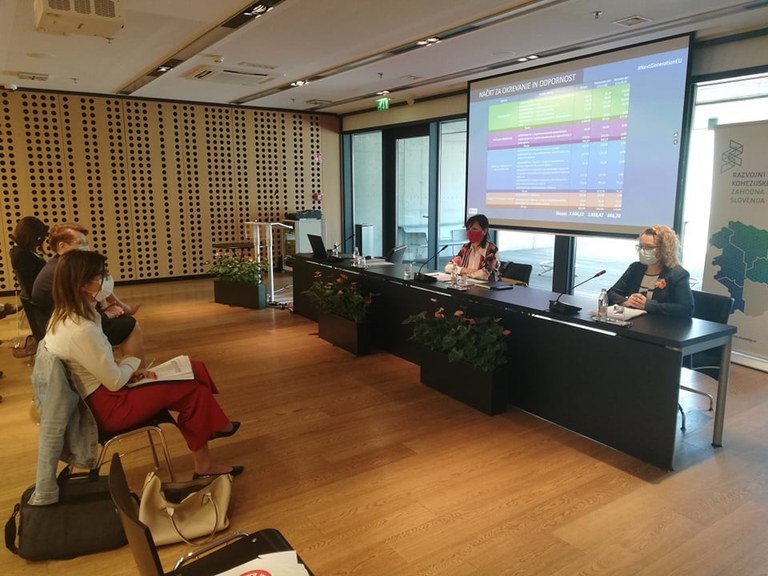
At the invitation of the Development Council of the cohesion region Zahodna Slovenija, State Secretary mag. Monika Kirbiš Rojs presented the Recovery and Resilience Plan and other financial mechanisms. The meeting took place on Wednesday, 2 June 2021, in Brdo pri Kranju. The planned measures were presented in more detail by the representatives of the Ministry of Economic Development and Technology, the Ministry of Health, the Ministry of Infrastructure and the Ministry of Labour, Family, Social Affairs and Equal Opportunities.
On 30 April 2021, Government Office for Development and European Cohesion Policy submitted its national Recovery and Resilience Plan to the European Commission for evaluation. The Plan covers EUR 1.8 billion in grants and slightly less than EUR 700 million in loans. The funding will be available to Slovenia by the end of 2026.
State Secretary mag. Monika Kirbiš Rojs thanked the Development Council members for the invitation and emphasized the importance of close cooperation with the cohesion regions in the process of programming European cohesion policy funds as well as the European recovery and resilience package. ‘Representatives of cohesion regions and local communities are key interlocutors in the process of planning EU funds spending, as you are thoroughly acquainted with the needs on the ground and have concrete experience in project planning. In the process of preparing the national Recovery and Resilience Plan, we tried to listen to your proposals to the greatest extent possible and at the same time follow the umbrella strategic priorities of the country and the guidelines of the European Commission,’ she underlined.
As she said, Slovenia has been developing the Recovery and Resilience Plan for nine months. ‘An intensive period of content preparation, reform design, numerous coordination meetings with various stakeholders and technical meetings with the European Commission is behind us. Through this process, we have identified four development areas: green transition; digital transformation; smart, sustainable and inclusive growth; healthcare and social security,’ she said. ‘Brussels announced this week that the decision on own resources has been ratified by all EU members, which enables the European Commission to borrow on the financial markets and thus finance the recovery after the COVID-19 pandemic. I am glad that we will soon be able to start with the implementation,’ said State Secretary.
Following the historic agreement at the EU summit last summer, when Slovenia negotiated an additional EUR 350 million for the cohesion region Zahodna Slovenija, the Government immediately proceeded to prepare its national Recovery and Resilience Plan. This is why the Government in last August organised a consultation with local communities and invited various stakeholders to submit their proposals. ‘The proposals of ministries and other stakeholders have helped us allocate funds by thematic areas and to define the reforms that are a key part of this strategic document,’ she said. Local community projects are not included in the plan, but call for proposals with clear criteria will be prepared for them. Municipalities, companies and others can expect the first calls for proposals to be published in the second half of 2021.
According to State Secretary, the demonstrated needs of ministries and local communities for co-financing exceeded the EU funding available to Slovenia by 2030. ‘It is crucial that we realistically assess which projects and programmes at both the state and local level can actually be realised. Namely, the implementation must start as soon as possible,’ she was clear. ‘The projects not being able to access the mentioned funding will be supported by future cohesion resources and the React-EU initiative in a complementary manner,’ she added.





